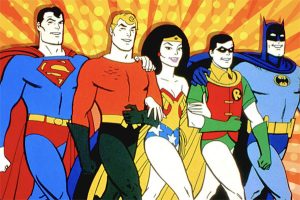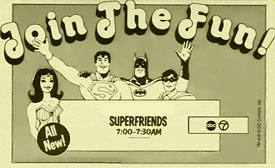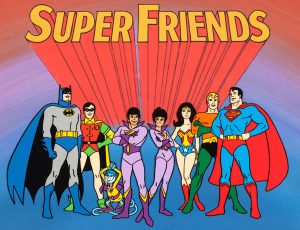
“Meanwhile, at the Hall of Justice…” Just hearing that line of booming narration from none other than Ted Knight means DC superheroes for many a generation.
Oh sure, there is a tremendous amount of focus on the DC universe today, thanks to big movies and big box office, but for so many Super Friends, Hanna-Barbera’s adaption of the DC comics, still stands as a wondrous Saturday morning window into this exciting world.
 Celebrating its 50th anniversary this year, Super Friends brought Superman, Batman, Robin, Wonder Woman, Aquaman, and many other members of DC Comics’ Justice League of America soaring off the page and onto TV screens.
Celebrating its 50th anniversary this year, Super Friends brought Superman, Batman, Robin, Wonder Woman, Aquaman, and many other members of DC Comics’ Justice League of America soaring off the page and onto TV screens.
Superman, Batman, Robin, and Aquaman had been brought to life in TV animation before this, in the 1960s, from the Filmation studio. Additionally, in the 70s, Filmation brought Wonder Woman and Superman back as guest stars on The Brady Kids, while Batman and Robin guest starred on Hanna-Barbera’s The New Scooby-Doo Movies.
The idea of bringing these superheroes together in a shared universe on a Saturday morning show began when ABC commissioned Hanna-Barbera to develop the series. The studio enlisted famed artist Alex Toth (who had created Space Ghost for Hanna-Barbera) to develop Super Friends.
 The show debuted on September 8, 1973. In each episode, at their headquarters, The Hall of Justice, Superman, Batman, Robin, Wonder Woman, and Aquaman would await word from Colonel Wilcox on the “Trouble Alert” computer, informing them of an emergency that required their attention.
The show debuted on September 8, 1973. In each episode, at their headquarters, The Hall of Justice, Superman, Batman, Robin, Wonder Woman, and Aquaman would await word from Colonel Wilcox on the “Trouble Alert” computer, informing them of an emergency that required their attention.
In addition to these traditional heroes, Super Friends also featured a very “Saturday morning touch,” with the addition of new characters: a pair of teenagers, Wendy Harris and Marvin White, along with their pet, Wonder Dog. They didn’t come with any superpowers but instead served as a way into the superhero world for kids watching at home and softened some of the edgier aspects of the comic book action.
This softer version of Super Friends was a big part of the show, debuting when concerns over violence in children’s television steered the show’s battles, while exciting, toward action where none of the characters would face harm. Additionally, each episode of Super Friends would include an educational and informative message.
The excellent voice cast included actor Olan Soule as Batman (he had also provided the character’s voice for Filmation and The New Scooby-Doo Movies), with Casey Kasem, iconically known as the voice of Shaggy on Scooby-Doo and as the host of radio’s American Top 40, as Robin.
Voice-over actor Danny Dark was Superman and noted actress Shannon Farnon was Wonder Woman. Character actor Norman Alden provided Aquaman’s voice. Hanna-Barbera’s stalwart voice actors filled out the cast with Sherri Alberoni as Wendy, Frank Welker as Marvin and Wonder Dog, and John Stephenson as Colonel Wilcox.
Additionally, while starring as anchorman Ted Baxter on the legendary Mary Tyler Moore Show, Ted Knight provided the perfect, rich narration for the show.
The actors and actresses of this talented cast would also play multiple roles of guests and recurring characters who would appear in each episode. These included The Flash and Plastic Man.
Super Friends was canceled after its first season and aired reruns after until the series was revised in 1977 as The All-New Super Friends Hour.
 This updated version jettisoned Wendy, Marvin, and Wonder Dog, replacing them with the Wonder Twins, Zan and Jayna, and their monkey, Gleek. The twins did have powers: Zan could morph into different forms of water, while Jayna could transform into animals. They did this after declaring, “Wonder Twin powers, activate!” another line from the series that’s become iconic.
This updated version jettisoned Wendy, Marvin, and Wonder Dog, replacing them with the Wonder Twins, Zan and Jayna, and their monkey, Gleek. The twins did have powers: Zan could morph into different forms of water, while Jayna could transform into animals. They did this after declaring, “Wonder Twin powers, activate!” another line from the series that’s become iconic.
In 1978, the series became Challenge of the Superfriends, and there were subsequent title changes as the show continued an impressive run through 1986.
Reflecting on the longevity of Super Friends, authors Joe Garner and Michael Ashley wrote in their book, It’s Saturday Morning: Celebrating the Golden Age of Cartoons, 1960s-1990s, that “… this show defined superheroes for a generation – exposing youngsters to amazing characters they may not have known without reading the grittier comics. Super Friends led with humor instead of violence and encouraged cooperation to battle the forces of evil. Most important of all, the show offered something invaluable. For several moments every Saturday morning, it presented an escape from humdrum reality, allowing boys and girls to dream of their own magical powers.”



 Michael Lyons is a freelance writer, specializing in film, television, and pop culture. He is the author of the book, Drawn to Greatness: Disney’s Animation Renaissance, which chronicles the amazing growth at the Disney animation studio in the 1990s. In addition to Animation Scoop and Cartoon Research, he has contributed to Remind Magazine, Cinefantastique, Animation World Network and Disney Magazine. He also writes a blog, Screen Saver: A Retro Review of TV Shows and Movies of Yesteryear and his interviews with a number of animation legends have been featured in several volumes of the books, Walt’s People. You can visit Michael’s web site Words From Lyons at:
Michael Lyons is a freelance writer, specializing in film, television, and pop culture. He is the author of the book, Drawn to Greatness: Disney’s Animation Renaissance, which chronicles the amazing growth at the Disney animation studio in the 1990s. In addition to Animation Scoop and Cartoon Research, he has contributed to Remind Magazine, Cinefantastique, Animation World Network and Disney Magazine. He also writes a blog, Screen Saver: A Retro Review of TV Shows and Movies of Yesteryear and his interviews with a number of animation legends have been featured in several volumes of the books, Walt’s People. You can visit Michael’s web site Words From Lyons at: 






















DC Comics has an illustrious history in animation going back to the Fleischer Superman cartoons. Filmation’s Superman established the studio as a contender in Saturday morning television programming. While I was never a fan of “Super Friends”, I think its greatest legacy was proving the viability of the DC characters in television animation, thus paving the way for the excellent Batman and Superman series produced by Warner Bros. in the ’90s.
Meanwhile, Marvel stumbled out of the gate with its barely animated Grantray-Lawrence superhero cartoons. Hanna-Barbera first tackled a Marvel property with its Fantastic Four series in the late ’60s, which I haven’t seen since then but remember as being pretty good. But while “Super Friends” was still going strong, H-B hit rock bottom with its execrable “Fred and Barney Meet The Thing” and its immortal catchphrase, “Thing Ring, do your thing!” Marvel may dominate DC at the box office when it comes to feature films, but in the medium of animation it isn’t even a close contest.
I just asked my wife if she remembered the Super Friends cartoon. She gaped at me in shock and said: “Don’t tell me they made a superhero cartoon out of ‘Friends’!” No, they didn’t, but oh! my! God! I wish they had. Could any idea BE more ridiculous?
Though the overall concept proved popular and endurable, there were a few aspects of that first season that got revised and overhauled in subsequent iterations of the series. The hour-long format tended to cause the stories to drag a bit, especially as the writers were constrained not to let anything truly “exciting” happen. And I have not encountered many fans who were greatly enamored of Wendy, Marvin, and Wonder Dog.
So the replacement of the non-super powered teens with the Wonder Twins was a step in the right direction, although as the series progressed, the role of Zan and Jayna was minimized until they only appeared in certain segments and eventually seem to have been phased out. I do recall a few episodes where they appeared mostly in the background and didn’t contribute substantially to the adventure. And some of the later shows didn’t give them a mention.
Dividing the show into shorter segments appears to have been a better idea, as the later stories are more concentrated and focused. Nor do they sag in the middle as so many of the hour-long ones did (not all, of course–even in the prototypical first season there were some episodes that shone as true gems). Some of the shorter segments featured only one or two of the heroes from the extended cast of characters. This provided more of an opportunity for individual characters to shine.
The Super Friends comic book added dimensions to the show, often filling in details that were otherwise missing. Most significantly, the comic book presented a multi-part story arc that involved the entire cast, including Wendy, Marvin, Wonder Dog, plus the Wonder Twins and Gleek, which ends in the passing of the torch from the first trio to the second. The story provides continuity to explain what happened to the first three and how they got replaced by the second three.
Also it is fascinating to observe how the series over the years incorporated aspects of the greater DC universe, making it accessible to non-comics readers (as well as those who were already fans of the comics) resulting in a kind of hybrid of Filmation, Hanna-Barbera, and DC. Now with most if not all of the series released on DVD, it provides viewers a chance to decide which series or season of Super Friends is their favorite. Plus some of the residue which spilled over into Scooby Doo, particularly in the team’s occasional association with Batman and Robin. (My above reference to Filmation is not a mistake–even though Hanna-Barbera produced the SF series it was evident from the get-go that the series was founded on the groundwork that Filmation had already laid in terms of how the DC characters were presented.)
I for one can testify that when I decided to venture into buying and reading DC comics, having a grounding in the Super Friends series made it easier to connect with the more “serious” DCU.
The weirdest series-to-comics was the Brainiac as pure robot. There may have been some C-3PO in the idea.
The facade of the Hall of Justice is based on the facade of Cincinnati Union Terminal railroad station. Probably not coincidentally, Cincinnati was the headquarters of Taft Broadcasting, which at that time owned Hanna-Barbera.
That oft-used promo artwork of the Friends doing that “Sex in the City” linked-arm side-by-side walk is a howler. Now I want to hear the husky voice of Wonder Woman performing Andrea True’s “More. More, More” to tie it all together.
For those interested, RETRO FAN MAGAZINE from TwoMorrows Publishing is about to conclude an in-depth four-part series on the myriad “Super Friends” series. Included in each chapter are plenty of model sheets, layouts, and storyboards. I’m not necessarily a fan of SF, but am enjoying the articles nonetheless. Here’s a link to the magazine [CLICK HERE].
I love Super Friends! I like it when superheroes were more fun than serious.
“Harvey Birdman Attorney at Law” riffed on the Superfriends. Apache Chief sued when spilled hot coffee left him unable to “get large”; on the witness stand Zan revealed he was Wonder Woman’s bathwater. I was a little late for this incarnation of DC, the Filmation shows imprinted on my young mind as how they were supposed to look: heavy black inking, and backgrounds with lots of shading and highlights on metal.
That must’ve been inspired by that case where an old woman spilled scalding-hot McDonald’s coffee on her lap and sued them.
Comedians of the time mocked her, saying she was stupid to not know that coffee was hot. But the coffee gave her third-degree burns and obviously was not safe to drink at that temperature, so it was not a frivolous lawsuit like they claimed. (IIRC the employee also didn’t put the lid on the cup correctly, which caused the spill in the first place.)
McDonald’s was serving their coffee way too hot to safely drink because customers would order coffee in the drive-thru and then complain that their coffee was cold by the time they drank it after they got to work. After the lawsuit they stopped this practice and served their coffee at a safe temperature.
in the show’s first incarnation, some of the other heroes such as Flash and Plastic Man would drop by for a brief appearance and help out when needed.
Hoyt Curtin really delivered on the theme song. Very patriotic and John Phillip Sousa sounding,
The Super Friend theme song is impeccable and one of my all-time favorites!
There’s more than a few miscreants in my generation whose knowledge of Super Friends came from internet comedian Seanbaby’s snarky, blue-mouthed rundown on the series.
Is there any reason why Wonder Woman was the only established female superhero that appeared in “Super Friends”? I know there weren’t that many during the show’s first incarnation, but I find it odd that at least Supergirl wasn’t used. Even during the show’s final incarnation as “Super Powers” (to tie-in Kenner’s toy line) where newer characters like Firestorm and “New Teen Titan’s” Cyborg (who wasn’t part of Justice league until much later) appeared we didn’t get heroines such as Zatanna or Fire and Ice on the show.
Probably just the entrenched beliefs that 90% of the show’s viewers and potential toy buyers were boys, and that boys wouldn’t buy toys of girls.
I remember reading an interview with someone that worked on the spinoff comic book.
He said the notes about the show he was given didn’t make any sense. Wendy was Bruce Wayne’s niece (despite Bruce being am only child) and called him “Uncle Bruce” in public while he was dressed as Batman.
This writer changed it so that Wendy was instead a relative of a dectective that had mentored Bruce Wayne, and dropped the stupid identity-blowing “Uncle Bruce” stuff.
I never saw the Wendy and Marvin version of the show, but I recall hearing that one or both of them was shown with powers (I think it was flight) in an early episode but that aspect was dropped early on.